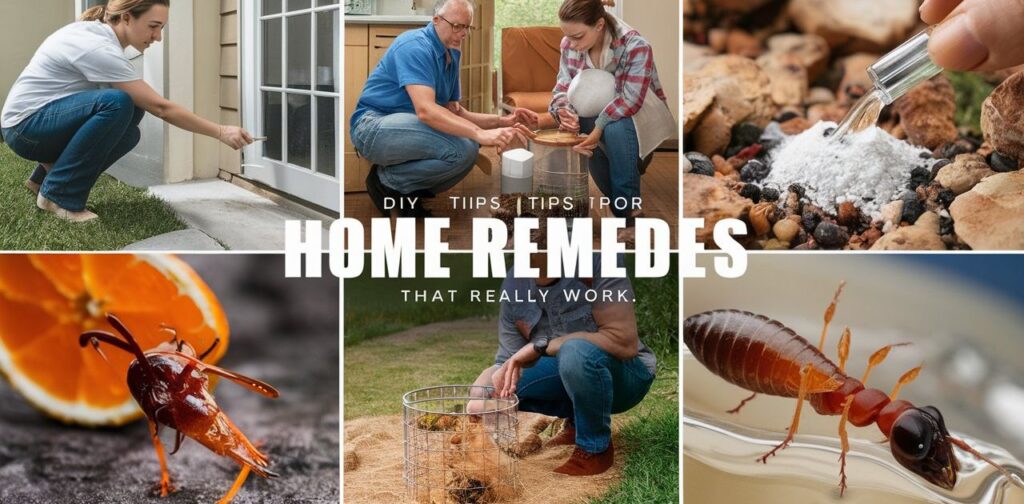Termites are one of the most destructive pests that can infest your home. These wood-eating insects can cause serious structural damage, slowly eating away at your home’s foundation, walls, floors, and furniture from the inside out. If left unchecked, a termite infestation can lead to costly repairs and put your family’s safety at risk.
While professional extermination is often necessary for severe infestations, there are many affordable and natural home remedies that can help eliminate termites and prevent future problems. In this comprehensive guide, we’ll explore 10 amazing home remedies to get rid of termites that are safe, effective, and inexpensive.
Whether you have a current termite issue or want to take preventative measures, these solutions will equip you with the knowledge and tools to protect your home from these destructive pests.
Before we dive into the home remedies, let’s understand what termites are and why they’re so problematic.
What are Termites?
Termites are small, wood-eating insects that live in colonies underground or within the wood they infest. There are several types of termites, but the most common ones that infest homes are subterranean termites, drywood termites, and dampwood termites.
These pests are particularly challenging to detect and eliminate because they can remain hidden within the wood for years, causing extensive damage before any visible signs appear. Some common signs of a termite infestation include:
- Mud tubes on exterior walls or the ground
- Hollow-sounding wood
- Piles of discarded wings or frass (termite droppings)
- Sagging floors or ceilings
- Cracked or bubbling paint
If you notice any of these signs, it’s crucial to take immediate action to address the termite problem before it escalates.
10 Effective Home Remedies to Get Rid of Termites

Now that you understand the threat termites pose, let’s explore 10 amazing home remedies that can help you get rid of these pests effectively.
Neem Oil
Neem oil is a natural, plant-based insecticide that’s remarkably effective against termites. Its potent compounds disrupt the termites’ hormone systems, making it difficult for them to reproduce and thrive.
To use neem oil, mix it with water according to the product’s instructions and spray it directly onto any infested areas or potential entry points. Repeat this process every few weeks until the infestation is eliminated.
Diatomaceous Earth
Diatomaceous earth is a powder made from fossilized algae that’s incredibly effective at eliminating termites and other insects. When termites come into contact with this powder, it damages their exoskeletons and causes them to dehydrate and die.
To use diatomaceous earth, simply sprinkle it around the areas where you suspect termite activity, such as baseboards, cracks, and crevices. Reapply the powder regularly until the infestation is under control.
Boric Acid
Boric acid is a naturally occurring mineral that’s highly toxic to termites but relatively safe for humans and pets when used correctly. When ingested by termites, boric acid disrupts their digestive system and causes them to dehydrate and die.
To use boric acid, create a bait by mixing it with a cellulose-based material (e.g., cardboard or wood shavings) and place the bait in areas where termites are active. The termites will consume the bait and spread it throughout their colony, effectively eliminating the infestation from within.
Vinegar
White vinegar is a versatile and affordable home remedy that can help get rid of termites. The acetic acid in vinegar is toxic to termites and can disrupt their chemical trails, making it difficult for them to navigate and communicate.
To use vinegar, mix equal parts vinegar and water in a spray bottle and spray the solution directly onto any infested areas or potential entry points. Repeat this process regularly until the termites are gone.
Orange Oil
Orange oil is a natural, plant-based insecticide that’s effective against termites and other insects. The d-limonene compound found in orange oil is toxic to termites and can disrupt their respiratory system, leading to their demise.
To use orange oil, mix it with water according to the product’s instructions and spray it onto infested areas or potential entry points. Repeat this process every few weeks until the infestation is eliminated.
Cold Treatment
Termites are sensitive to extreme temperatures, and cold temperatures can be an effective way to eliminate them. By exposing infested areas to temperatures below 15°F (-9°C) for an extended period, you can kill termites and prevent further infestations.
To perform a cold treatment, you may need to rent or purchase specialized equipment, such as a portable freezer or liquid nitrogen system. This method is best left to professionals or experienced individuals, as it can be challenging and potentially hazardous if not done correctly.
Heat Treatment
Similar to cold treatment, heat can also be an effective way to eliminate termites. By exposing infested areas to temperatures above 120°F (49°C) for several hours, you can kill termites and their eggs, effectively eliminating the entire colony.
Heat treatment can be performed using specialized equipment, such as portable heaters or heat tents. However, this method should also be left to professionals or experienced individuals, as it can be dangerous and potentially cause damage if not done correctly.
Salt Solution
How to get rid of termites with home remedy of Salt: Salt is a simple and affordable home remedy that can help get rid of termites. When exposed to high concentrations of salt, termites become dehydrated and eventually die.
To use salt as a termite treatment, mix a solution of salt and water (approximately 1 cup of salt per gallon of water) and spray it onto infested areas or potential entry points. Repeat this process regularly until the infestation is eliminated.
Petroleum Jelly or Aloe Vera
Petroleum jelly and aloe vera can be effective barriers against termites, as they can suffocate and dehydrate the insects when applied to infested areas.
To use petroleum jelly or aloe vera, apply a thick layer of the substance to any infested areas or potential entry points. This barrier can help prevent termites from entering or exiting the infested area, ultimately leading to their demise.
Cardboard Trap
Termites are attracted to cellulose, which is found in wood and cardboard. You can use this attraction to your advantage by creating a cardboard trap to lure and eliminate termites.
To create a cardboard trap, dampen a piece of cardboard and place it near an area where you’ve noticed termite activity. The termites will be drawn to the cardboard, and once they’ve infested it, you can remove and dispose of the cardboard, along with the termites.
Recommended Post: Does A Bedroom Have To Have A Window
Termite Prevention Tips
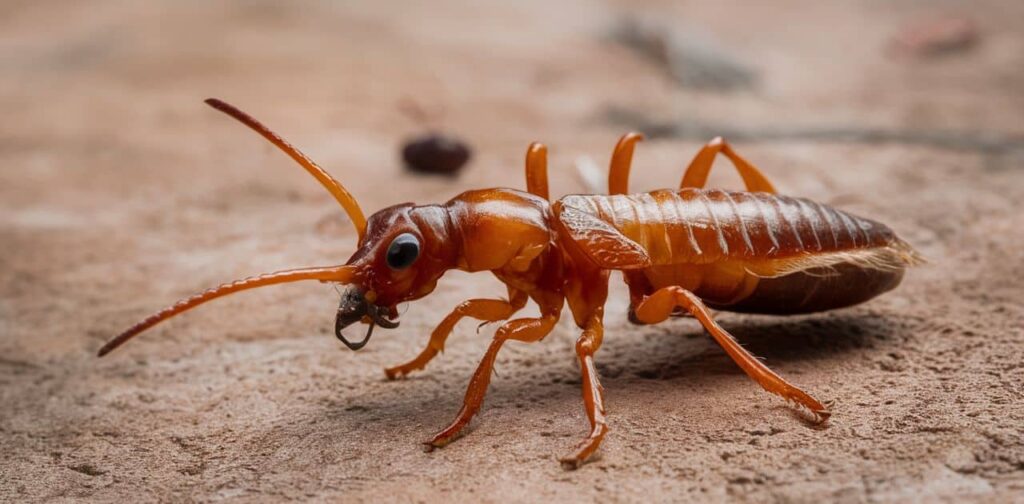
While home remedies can be effective at eliminating existing termite infestations, prevention is key to avoiding future problems. Here are some helpful tips to protect your home from termites:
- Eliminate moisture sources: Termites thrive in damp environments, so it’s essential to address any moisture issues in and around your home. Fix leaks, improve ventilation, and direct water away from the foundation.
- Remove wood debris: Piles of firewood, stumps, or other wood debris near your home can attract termites. Keep these materials away from your home’s foundation and stored off the ground.
- Maintain proper drainage: Ensure that water drains away from your home’s foundation to prevent moisture buildup, which can attract termites.
- Seal entry points: Caulk and seal any cracks or crevices in your home’s exterior, as termites can use these as entry points.
- Schedule regular inspections: Have a professional pest control company inspect your home annually for signs of termites or other pests. Early detection is crucial for effective treatment.
When to Call a Professional
While home remedies can be effective in certain situations, severe termite infestations often require professional intervention. If you’ve tried multiple home remedies without success or if the infestation appears widespread, it’s time to call in a professional exterminator.
Professional exterminators have access to specialized tools and treatments, such as termite baiting systems or fumigation, which can effectively eliminate even the most stubborn termite colonies. They also have the expertise to identify the extent of the infestation and implement targeted treatment plans.
Don’t wait until the damage is severe or costly – if home remedies aren’t working, seek professional help to protect your home and avoid further damage.
How to Get Rid of Termites Permanently

Eliminating a termite infestation permanently can be a challenging task, as these persistent pests can quickly re-establish their colonies if not addressed properly. While home remedies can be effective in managing mild to moderate infestations, severe cases may require professional intervention with specialized treatments.
To increase your chances of permanently getting rid of termites, consider the following strategies:
- Combine Multiple Home Remedies: Instead of relying on a single home remedy, combine various methods for a more comprehensive approach. For example, you could use neem oil, diatomaceous earth, and boric acid baits simultaneously to target termites from multiple angles.
- Treat Regularly and Consistently: Consistency is key when using home remedies against termites. Treat infested areas regularly, following the recommended application schedules, to ensure the remedies have a lasting impact on the colony.
- Eliminate Moisture Sources: Termites thrive in damp environments, so addressing moisture issues in and around your home is crucial for long-term prevention. Fix leaks, improve ventilation, and direct water away from the foundation to create an inhospitable environment for termites.
- Remove Wood Debris and Potential Entry Points: Eliminate any wood debris, such as firewood, stumps, or other cellulose-rich materials, from around your home, as these can attract and sustain termite colonies. Additionally, seal any cracks or crevices in your home’s exterior to prevent termites from gaining entry.
- Consider Professional Assistance: If home remedies prove ineffective or the infestation is particularly severe, it may be necessary to seek professional assistance from a licensed exterminator. Professionals have access to specialized treatments, such as termite baiting systems or fumigation, which can provide a more comprehensive and long-lasting solution.
By implementing a combination of home remedies, addressing moisture issues, removing potential food sources, and seeking professional help when needed, you can increase your chances of permanently eliminating a termite infestation and preventing future infestations.
Home Remedy for Termites in Wall
Termite infestations in walls can be particularly challenging to address, as the pests may be hidden from sight and difficult to access. However, there are several effective home remedies that can help eliminate termites in walls:
Vinegar Solution
Vinegar is a versatile and affordable home remedy that can be used to combat termites in walls. Mix equal parts white vinegar and water in a spray bottle, and liberally spray the solution onto any areas where you suspect termite activity, such as cracks, crevices, or baseboards near the affected walls.
Boric Acid
Powder Boric acid is a naturally occurring mineral that is highly toxic to termites. You can use a hand duster or puffer to blow boric acid powder into any cracks, crevices, or entry points in the affected walls. The termites will come into contact with the powder and ingest it, leading to their eventual demise.
Diatomaceous Earth
Diatomaceous earth is a powder made from fossilized algae that can effectively eliminate termites. Sprinkle diatomaceous earth along baseboards, in wall cavities (if accessible), and around potential entry points. As termites crawl through the powder, it will damage their exoskeletons and cause dehydration.
Cold or Heat Treatment
Extreme temperatures can be effective in killing termites within walls. While these methods are best left to professionals, you could attempt to either expose the infested walls to very cold temperatures (below 15°F/-9°C) for an extended period or use portable heaters to raise the temperature within the walls to above 120°F/49°C for several hours.
When using home remedies for termites in walls, it’s essential to be patient and persistent. Treating the affected areas regularly and consistently is crucial to ensuring the remedies have a lasting impact on the termite colony.
How to Get Rid of Termites in Wall
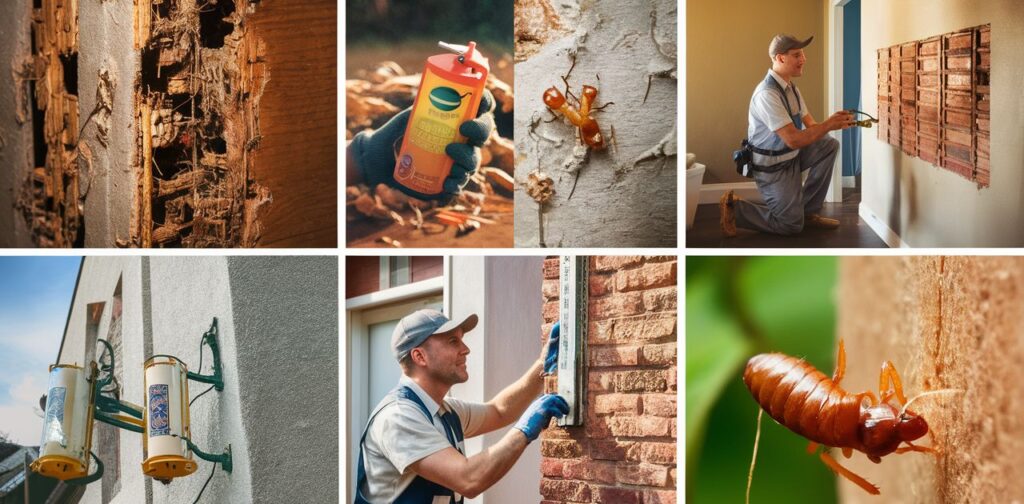
Addressing a termite infestation in walls can be a challenging task, as these pests often remain hidden from sight and can cause significant structural damage if left unchecked. Here are some effective methods for getting rid of termites in walls:
Locate the Infestation
The first step is to identify the areas where termites are active within your walls. Look for signs such as mud tubes, discarded wings, or wood damage. You can also use a stud finder or tap on the walls to listen for hollow sounds, indicating potential termite activity.
Drill and Treat
Once you’ve identified the infested areas, you can use a drill to create small holes in the walls. Through these holes, you can inject insecticidal dusts, such as boric acid or diatomaceous earth, directly into the wall cavities where termites are active. This will ensure the treatment reaches the termites and their colonies.
Use Liquid Treatments
In addition to insecticidal dusts, you can also use liquid treatments to target termites in walls. Solutions like vinegar, orange oil, or neem oil can be sprayed or injected into the wall cavities through the drilled holes. These liquids can penetrate deep into the wood, reaching termites that may be hidden from sight.
Consider Foam Treatments
For hard-to-reach areas or particularly severe infestations, foam treatments can be an effective option. These treatments involve injecting an insecticidal foam into the wall cavities, which can expand and reach termites in even the smallest crevices.
Address Moisture Issues
Termites are attracted to moisture, so addressing any leaks, poor ventilation, or other moisture issues within your walls is crucial. Fix any plumbing problems, improve air circulation, and consider using dehumidifiers to create an inhospitable environment for termites.
Seek Professional Assistance
In cases of severe or widespread infestations, it may be necessary to seek professional assistance from a licensed exterminator. Professionals have access to specialized tools and treatments, such as termite baiting systems or fumigation, which can provide a more comprehensive solution for eliminating termites in walls.
When dealing with termites in walls, patience and persistence are key. Regular monitoring and consistent treatment are essential to ensure the complete elimination of the infestation and to prevent future infestations from occurring.
What Chemical Kills Termites in Wood?
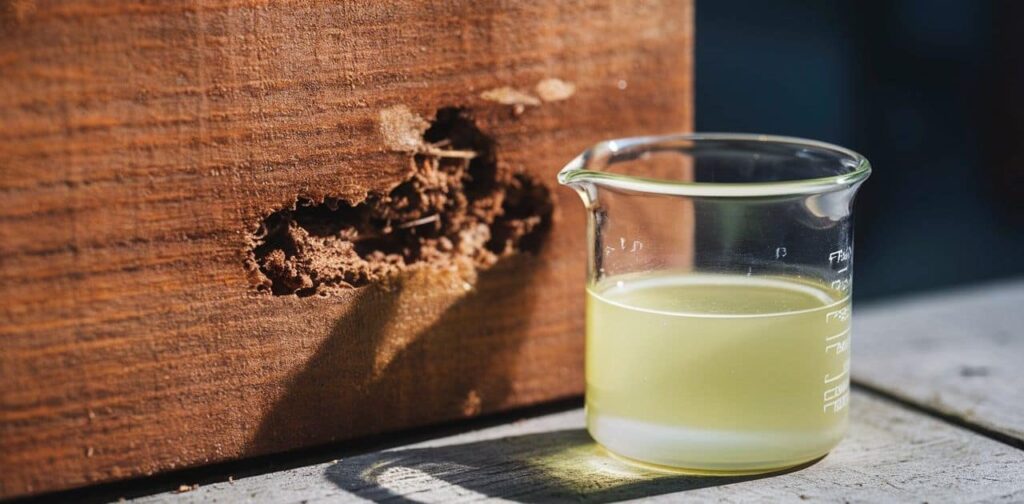
While there are several effective home remedies for eliminating termites in wood, in some cases, chemical treatments may be necessary, particularly for severe infestations or when dealing with certain types of termites.
Here are some commonly used chemical treatments for killing termites in wood:
Termiticides
Termiticides are insecticides specifically designed to kill termites. These chemicals can be applied directly to infested wood or used as a soil treatment to create a barrier around the structure. Common termiticides include:
- Fipronil
- Imidacloprid
- Chlorfenapyr
- Bifenthrin
Boric Acid
Although boric acid is often considered a natural remedy, it is also a chemical compound that can effectively kill termites when used in high concentrations. Boric acid can be injected into infested wood or used as a bait to eliminate termite colonies from within.
Borates
Borates, such as disodium octaborate tetrahydrate (DOT), are inorganic compounds that can be used as wood preservatives to prevent termite infestations. They can also be injected into infested wood to eliminate existing termite colonies.
Sulfuryl Fluoride
Sulfuryl fluoride is a fumigant gas that can be used for whole-structure treatment. This gas penetrates deep into wood and other materials, killing termites and their eggs throughout the infested area.
It’s important to note that chemical treatments should only be administered by licensed professionals who are trained in proper handling and application methods. Improper use of these chemicals can be hazardous to human and environmental health.
Additionally, chemical treatments may not be suitable for all situations, particularly in cases where wood is intended for human contact or consumption (e.g., furniture, kitchen cabinets). In such cases, natural home remedies or non-chemical treatments may be preferred.
How to Get Rid of Termites in Furniture?
Termite infestations in furniture can be particularly concerning, as these pests can quickly cause extensive damage to your valuable possessions. Here are some effective methods for getting rid of termites in furniture:
- Identify the Affected Pieces: The first step is to identify which pieces of furniture are infested with termites. Look for signs such as wood damage, discarded wings, or termite droppings (frass). You may also notice hollow-sounding wood or sagging areas, indicating internal damage.
- Isolate the Infested Furniture: Once you’ve identified the affected pieces, isolate them from the rest of your furniture to prevent the termites from spreading to other items.
- Use Heat or Cold Treatment: Extreme temperatures can be effective in killing termites in furniture. You can either expose the infested pieces to very cold temperatures (below 15°F/-9°C) for an extended period or use a portable heater to raise the temperature within the furniture to above 120°F/49°C for several hours.
- Apply Insecticidal Dusts: Insecticidal dusts, such as boric acid or diatomaceous earth, can be injected or carefully applied to the infested areas of your furniture. These dusts will kill termites on contact and continue to work as the termites groom themselves and ingest the particles.
- Try Orange Oil or Neem Oil: Natural oils like orange oil or neem oil can be effective in eliminating termites from furniture. These oils contain compounds that are toxic to termites and can penetrate deep into the wood. Apply the oils liberally to the affected areas and repeat the treatment as necessary.
- Consider Professional Fumigation: For severe infestations or particularly valuable pieces of furniture, professional fumigation may be necessary. This process involves sealing the furniture in a tent or chamber and releasing a gas fumigant that penetrates deep into the wood, killing termites and their eggs.
- Implement Prevention Strategies: Once you’ve eliminated the termite infestation, take steps to prevent future infestations. This might include sealing any cracks or crevices in the furniture, reducing moisture levels, and regularly inspecting your furniture for signs of termite activity.
Remember, termite infestations in furniture can be challenging to address, and patience and persistence are key. If you’re unsure about the extent of the infestation or the effectiveness of your efforts, it may be best to seek professional assistance.
How to Get Rid of Flying Termites?
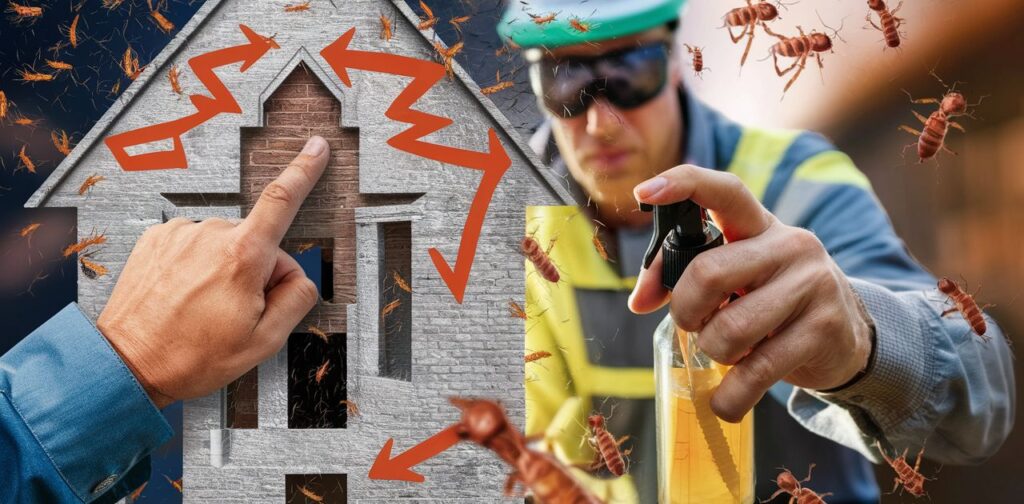
Spotting flying termites, also known as swarmers, can be a concerning sign of a potential termite infestation. These winged termites are reproductive members of the colony that are searching for new nesting sites, indicating an established colony nearby. To address this issue, you can try the following methods:
Identify the Source
Flying termites are often the first visible sign of an infestation, but they don’t necessarily indicate the location of the colony. Try to locate the source by inspecting your home for other signs of termite activity, such as mud tubes, wood damage, or frass (termite droppings).
Use Bug Zappers or Fly Swatters
While not a long-term solution, bug zappers or fly swatters can be used to eliminate the flying termites you see. However, keep in mind that this method only addresses the swarmers and not the underlying colony.
Set Cardboard Traps
Termites are attracted to cellulose-rich materials like cardboard. You can use this to your advantage by setting up dampened cardboard traps near areas where you’ve spotted flying termites. Once the termites have infested the cardboard, you can dispose of the trap and the termites within it.
Apply Cedar Mulch or River Rock
Subterranean termites dislike the natural compounds found in cedar mulch, which can act as a deterrent. You can also use river rock around your home’s foundation, as the lack of organic material makes it less attractive to termites.
Treat with Insecticides or Baits
If you’ve identified the location of the termite colony, you can treat the area with insecticides or termite baits. These products are designed to eliminate the colony from within, as worker termites bring the toxic substances back to the nest.
Consider Professional Treatment
For severe infestations or when the colony’s location is difficult to identify, it may be necessary to seek professional assistance. Exterminators have access to specialized treatments, such as termite baiting systems or fumigation, which can effectively eliminate even well-established termite colonies.
Remember, flying termites are a sign of an active infestation, and addressing the underlying colony is crucial to preventing further damage and infestations.
How to Get Rid of Termites in the Soil?
Subterranean termites build their colonies in the soil, making it essential to target the soil surrounding your home to effectively eliminate these pests. Here are some methods you can use to get rid of termites in the soil:
- White Vinegar Solution: Create a solution of white vinegar and water (1 part vinegar to 4 parts water) and apply it to the soil around your home’s foundation and any areas where you suspect termite activity. The acidity of the vinegar can kill termites on contact and disrupt their chemical trails.
- Cayenne Pepper or Chili Powder: Termites are sensitive to the capsaicin found in cayenne pepper and chili powder. Sprinkle these powders liberally around the perimeter of your home and in any suspected termite-infested areas of the soil.
- Insecticidal Soap: Insecticidal soaps can be effective in killing termites in the soil. Mix the soap with water according to the product instructions and drench the soil around your home’s foundation and any potential termite entry points.
- Nematodes: Nematodes are microscopic worms that can be highly effective in eliminating termite colonies in the soil. These beneficial nematodes seek out and infect termites, eventually killing them. You can purchase nematodes from garden supply stores or online retailers and apply them to the soil surrounding your home.
- Cardboard Traps: As mentioned earlier, termites are attracted to cellulose-rich materials like cardboard. You can bury dampened cardboard traps in the soil around your home to lure termites and monitor their activity. Once the cardboard is infested, you can dispose of the trap and the termites within it.
- Chemical Soil: Treatment In cases of severe infestations, you may need to consider chemical soil treatments. These treatments involve applying termiticides or insecticides to the soil around your home’s foundation, creating a barrier that prevents termites from entering the structure.
Remember, treating the soil is crucial for addressing subterranean termite infestations, as it targets the source of the problem. Consistent monitoring and treatment may be necessary to ensure the complete elimination of the colony.
How to Get Rid of Termites in Plants?
Termites pose a serious threat to gardens and landscaping by feeding on cellulose in plants, mulch, and debris. Protect your plants with wet cardboard traps – bury damp cardboard near infested areas to lure termites, then dispose of the trap. Nematodes are microscopic worms that infect and kill termites; apply them to soil around plants. Careful watering prevents creating moist environments termites thrive in. Remove wood debris like branches, logs, and mulch that attract termites.
Treat affected areas with insecticidal soaps or oils like neem or orange oil that kill termites on contact. For severe infestations or valuable plants, seek professional exterminator assistance for specialized termite treatments and guidance. Consistent monitoring and addressing conducive conditions are key to eliminating termites from your garden.
Termite Treatment at Home Price
If you’ve decided to pursue professional termite treatment for your home, it’s important to understand the potential costs involved. The price of termite treatment can vary depending on several factors, including the extent of the infestation, the type of treatment required, and the size of your home.
Here’s an overview of the typical costs associated with different types of termite treatments:
Termite Inspection
Before any treatment can begin, a thorough termite inspection is usually required. This involves a professional exterminator inspecting your home for signs of termite activity and assessing the extent of the infestation. The cost of a termite inspection typically ranges from $75 to $200.
Liquid Termiticide Treatment
One of the most common methods for termite treatment is the application of liquid termiticides. This involves trenching around the perimeter of your home and applying a liquid insecticide to create a barrier against termites. The cost of liquid termiticide treatment can range from $800 to $3,000, depending on the size of your home and the extent of the infestation.
Termite Baiting System
Termite baiting systems are another popular option for termite control. These systems involve placing bait stations around your home, which contain a slow-acting insecticide that termites bring back to their colony. The cost of installing a termite baiting system typically ranges from $1,000 to $2,500, with additional costs for ongoing monitoring and bait replacement.
Fumigation
In cases of severe or widespread infestations, fumigation may be necessary. This process involves sealing your home in a tent and releasing a gaseous insecticide to penetrate deep into the wood and eliminate termites. Fumigation is typically the most expensive termite treatment option, with costs ranging from $3,000 to $8,000 or more, depending on the size of your home.
Heat Treatment
Heat treatment is another effective method for termite control, particularly for localized infestations or specific areas of your home. This process involves raising the temperature in the affected areas to levels that are lethal to termites but safe for humans and pets. The cost of heat treatment can range from $1,000 to $3,000, depending on the size of the area being treated.
It’s important to note that these cost estimates are approximate and can vary based on your location, the specific pest control company, and any additional services or treatments required. Additionally, many companies offer warranties or annual maintenance plans, which can add to the overall cost but provide ongoing protection against future termite infestations.
When considering termite treatment options, it’s always best to obtain multiple quotes from reputable pest control companies and carefully compare their services, pricing, and warranties. While the upfront cost of professional termite treatment may seem high, it’s often a worthwhile investment to protect your home from the potentially devastating damage caused by termites.
| Treatment Method | Description | Approximate Cost |
| Termite Inspection | Professional inspection to assess the extent of infestation. | $75 – $200 |
| Liquid Termiticide | Application of liquid insecticides to create a barrier against termites. | $800 – $3,000 |
| Termite Baiting System | Placement of bait stations around the home with slow-acting insecticides. | $1,000 – $2,500 + ongoing monitoring costs |
| Fumigation | Sealing the home and releasing gaseous insecticides for severe infestations. | $3,000 – $8,000+ |
| Heat Treatment | Raising temperatures to lethal levels for termites in specific areas. | $1,000 – $3,000 |
Conclusion
Termites are a serious threat to any home, capable of causing extensive damage that can compromise a structure’s integrity and safety. While professional extermination may be necessary in severe cases, homeowners have access to a range of effective and affordable home remedies that can help eliminate termite infestations and prevent future problems.
By understanding the signs of termite activity and implementing the natural solutions outlined in this guide, you can take proactive steps to protect your property from these destructive pests. From neem oil and diatomaceous earth to boric acid and vinegar, these home remedies offer safe and environmentally friendly alternatives to harsh chemical treatments.
However, it’s important to remain vigilant and address any potential termite issues promptly. Regular inspections, moisture control, and the removal of wood debris can go a long way in preventing future infestations and maintaining the integrity of your home.
If you’ve tried multiple home remedies without success or suspect a severe infestation, don’t hesitate to seek professional help. Exterminators have access to specialized tools and treatments that can effectively eliminate even the most stubborn termite colonies, ensuring that your home remains safe and structurally sound.
Remember, termites are persistent and can cause significant damage if left unchecked. By taking action and utilizing the home remedies and prevention tips outlined in this guide, you can safeguard your home and protect your investment from the destructive effects of these wood-eating pests.
Frequently Asked Questions
How can I tell if I have a termite infestation?
Some common signs of a termite infestation include mud tubes on exterior walls, hollow-sounding wood, piles of discarded wings or frass (termite droppings), sagging floors or ceilings, and cracked or bubbling paint. If you notice any of these signs, it’s crucial to investigate further and take action.
Are home remedies for termites effective for all types of infestations?
Home remedies can be effective for mild to moderate termite infestations, particularly if addressed early. However, severe or extensive infestations may require professional intervention and specialized treatments, such as termite baiting systems or fumigation.
How long does it take for home remedies to work against termites?
The effectiveness of home remedies can vary depending on the severity of the infestation, the specific remedy used, and how consistently it’s applied. In general, you may start seeing results within a few weeks, but it can take several months to fully eliminate a termite colony using home remedies alone.
Are these home remedies safe for use around children and pets?
Many of the home remedies mentioned, such as neem oil, diatomaceous earth, vinegar, and orange oil, are considered relatively safe for use around children and pets when used as directed. However, it’s always important to exercise caution, keep these substances away from areas accessible to children and pets, and follow the product instructions carefully.
Can home remedies prevent future termite infestations?
While home remedies are primarily used to eliminate existing termite infestations, some of these solutions, such as neem oil and diatomaceous earth, can also act as deterrents and preventative measures against future infestations when applied regularly in high-risk areas.
Is it necessary to treat the entire home when using home remedies for termites?
The extent of treatment required will depend on the severity and location of the infestation. In some cases, treating specific areas or potential entry points may be sufficient, while more widespread infestations may require treating the entire home or surrounding areas.
Can home remedies cause damage to my home or belongings?
When used as directed, most of the home remedies mentioned in this guide are relatively safe and should not cause damage to your home or belongings. However, it’s always important to follow the product instructions carefully and exercise caution when applying any substance, especially around sensitive materials or surfaces.
How can I prevent future termite infestations after eliminating an infestation with home remedies?
To prevent future termite infestations, it’s essential to address any moisture issues, remove wood debris, maintain proper drainage, seal entry points, and schedule regular professional inspections. Additionally, some home remedies, such as neem oil and diatomaceous earth, can be applied as preventative measures in high-risk areas.
Summary
Remember, while home remedies can be effective in managing termite infestations, they may not always be sufficient for severe cases. If you’re unsure about the extent of the infestation or the effectiveness of your efforts, it’s always best to consult with a professional exterminator to ensure the safety and integrity of your home.
By combining home remedies with preventative measures and professional assistance when necessary, you can effectively protect your property from the destructive effects of termites and maintain a healthy, pest-free living environment.

